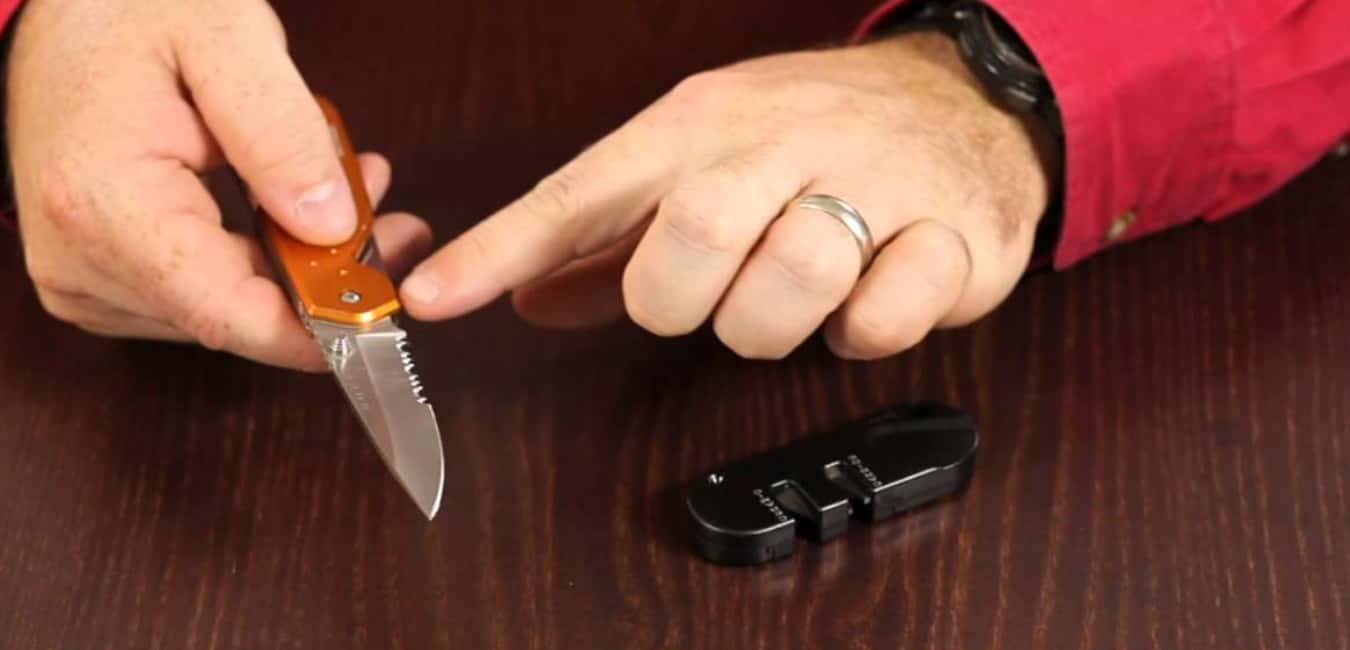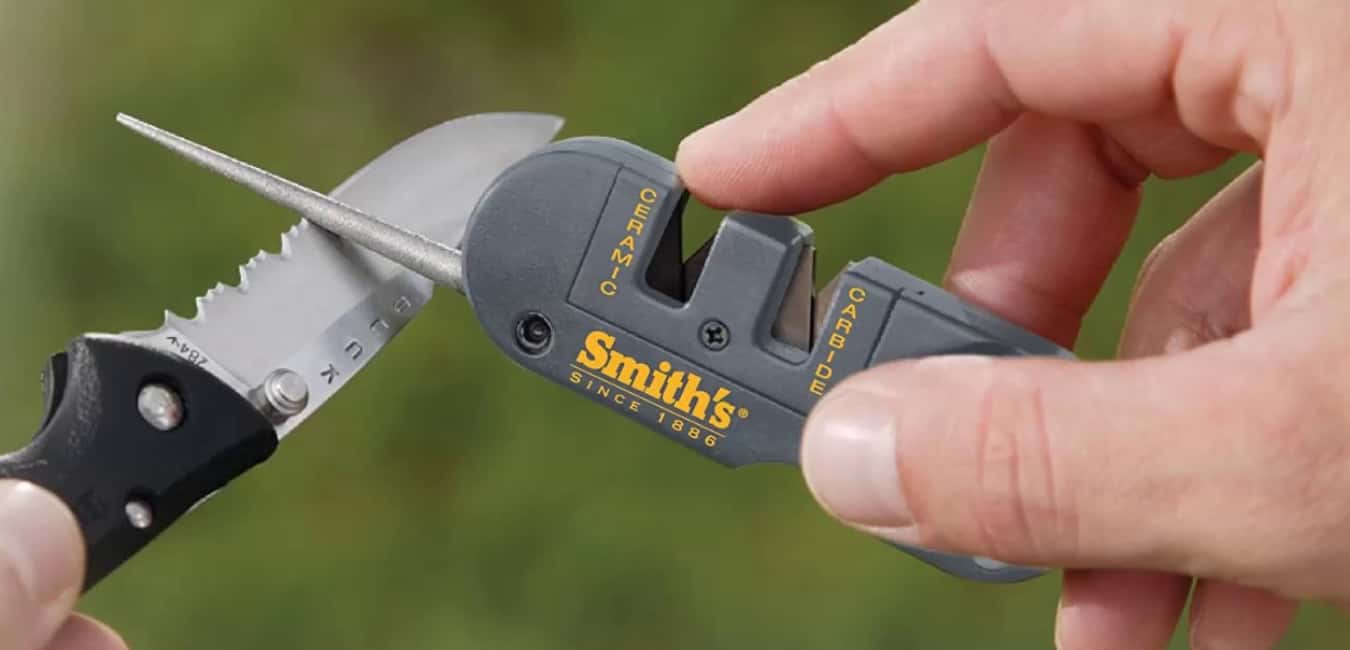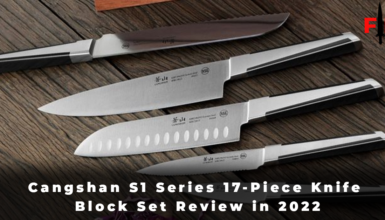Featuring pre-set cross-carbide and ceramic stones, Smith’s “Pocket Pal” Multi-Functional Knife Sharpener provides the perfect edge every time. A carbide provides a quick edge setting, and ceramic stones, which have a specially shaped surface, can deliver a razor-sharp edge on any surface. Designed for sharpening serrations and small gut hooks, this round, fold-out diamond-coated rod folds out into a cone. With a lanyard hole, it is compact, lightweight, and durable.
When talking about Smith’s sharpening tools, people often ask “How do you use a Smith’s pull-through knife sharpener?” Here’s the answer. Place the pull-through sharpener on the countertop or any surface. Hold the knife in your dominant hand and grip the sharpener with your other hand. Now insert the knife into the sharpening slot and perform 5 to 6 strikes while pulling the knife from heel to tip. Repeat for the other slots as well.
In this article about the Smith’s Abrasives, we’re going to review the Pocket Pal knife sharpener by Smith.
Table of Contents
How to Sharpen a Knife with Smith’s Pocket Pal?
Three different sharpening mediums are included in Smith’s Pocket Pal. Diamonds, ceramic, and tungsten carbide are all harder than steel, so this tool could be used on any steel blade knife.
The Smith’s PP1 sharpener is designed to sharpen a knife by simply dragging it repeatedly over the two V-shaped grooves: first across one, then across the other.
In order to create an edge, first, you need to use the tungsten carbide side. It generates an edge like carving rather than grinding, which is a very fast process as well. It is fairly accurate to describe what actually happens; as soon as you notice a nice burr on the edge, you can move on to the ceramic side of the sharpener and repeat the steps.
How do you use a Smith’s yellow knife sharpener?
Smith’s yellow knife sharpener is a great tool for sharpening knives as well as both the left-handed and right-handed scissors. The sharpener has two different slots, one for the knife sharpening and the other for the scissors sharpening.
To sharpen the knives, hold the knife on a flat surface with the cutting edge facing upwards. Make sure the blade extends one inch past the edge. Hold the sharpener and put the sharpening slot over the blade and pull from heel to the tip. Follow the curvature of the knife’s blade and use moderate downward pressure on the knife. Repeat the process until the blade becomes sharp.
How do you sharpen scissors with a Smith knife sharpener?
To sharpen the scissors, use either the right-hand side or the left-hand side. Hold the sharpener upright with the appropriate side facing you. Insert the scissors into the slot and close them onto the rod and then pull them through the slot while trying to keep them closed. After use, clean the sharpener with a cloth, and DO NOT wash the sharpener.
Smith’s Abrasives Pocket Pal PP1 Reviews
Smith’s Pocket Pals are considered to be one of the very best sharpening stones available in the market. They are pretty easy and convenient to use while being easily portable as well. These sharpeners could easily be folded and kept in pockets without any danger. Here, we’ll further discuss some great aspects of Smith’s Pocket Pal sharpeners.
- Quality
- Performance
- Features
- How to Use
1. Quality
Pocket Pal PP1 is only one ounce in weight, so it feels a bit flimsy. In spite of this, it is made of sturdy plastic and was able to withstand a drop from 2 meters on concrete without even a scratch.
The replacement carbide blade and ceramic stones are secured with a sliding tray with a metal screw on the underside, while the tapered diamond rod appears to be attached with a plastic hinge. With a cost of fewer than ten bucks, the Pocket Pal is a good value. Due to the strong nature of the sharpening components, their plastic package does not really make a huge difference. There are other good things to be considered about its quality.
2. Performance
Along with being portable, super convenient to use, and excellent user experiences, this sharpener excels in its performance. The edge can be brought back to razor-sharp in just a few strokes. Pocket Pal’s field-expedient sharpening abilities make it an ideal companion in any scenario.
Sharpening dull knives is very fast with the course, carbide blades. A carbide blade restores a decent edge to a dull knife after treatment. Ceramic stones are great for polishing an edge that has already been sharpened. These stones provide a smooth and polished edge.
Fold-out diamond rods are available with a 400-grit surface, which is ideal for sharpening serrated and standard edges but what is liked most about this rod is how well it works on crooked Mora spoon knives.
3. Features
- Sharpening Rod for Serrated and Standard Edges with Tapered Round Diamond Coated Rod.
- The Carbide Blade sets your edge quickly; the Ceramic Stone sets your edge razor sharp.
- Easily replaceable and reversible carbide and ceramic stones for long-term sharpening.
- Lanyard Carrying hole provides an easy grip to the user.
- Angles are guaranteed to achieve maximum sharpness.
4. How to Use
Here are the exact steps you’ll need to follow to sharpen a knife with Smith’s Pocket Pal sharpener.
- To start sharpening your knife, you’ll need to place it on a solid surface with the edge facing up and hold the handle in place with your hand. For the highest results, let the blade extend 1 inch beyond the solid surface.
- Sharpen the knife by inserting the edge inside the V in the head of the sharpener.
- The sharpener’s head should also be angled at 90 degrees above the cutting edge of the knife. Use one hand to hold the knife and the other to hold the sharpener.
- As you sharpen the blade, apply a low- to medium-pressure with the sharpener. Don’t worry about feeling the metal scrape off of the knife because that is perfectly normal.
- The process will need to be repeated about four to five times until the knife feels sharp enough.
- Make sure you DO NOT apply too much force or pressure to the knife. Light pressure is sufficient enough.
Smith Pocket Pal Knife Sharpener Instructions
- Keep your eyes on the knife and make sure it is perfectly angled.
- If you are a beginner, you should ask someone who has more experience or use a disposable knife. In case your angle is incorrect, you may damage the entire knife. Deformed knives are also damaged knives and using them can be dangerous for a variety of reasons. Firstly, they are unbalanced. Secondly, f it breaks, you might hurt yourself.
- The blade should be pushed up and away from your body after it is placed on the angle guide.
- Do not exert too much pressure. Otherwise, you will leave scratches on the blade.
- When you are finished sharpening one side, move to the other side.
Pros and Cons
Our Verdict
Smith’s Pocket Pal knife sharpeners are pretty simple to use. They may require some practice but once you know how to use them in the right way, they’re super convenient to use. If you’re a beginner, we would recommend you try sharpening an old knife first. This is because if done in an incorrect manner, your knife might get damaged.
Hence, it is better to start with an old knife and then go for your actual kitchen knives when you know how to exactly use the Pocket Pal knife sharpener.






